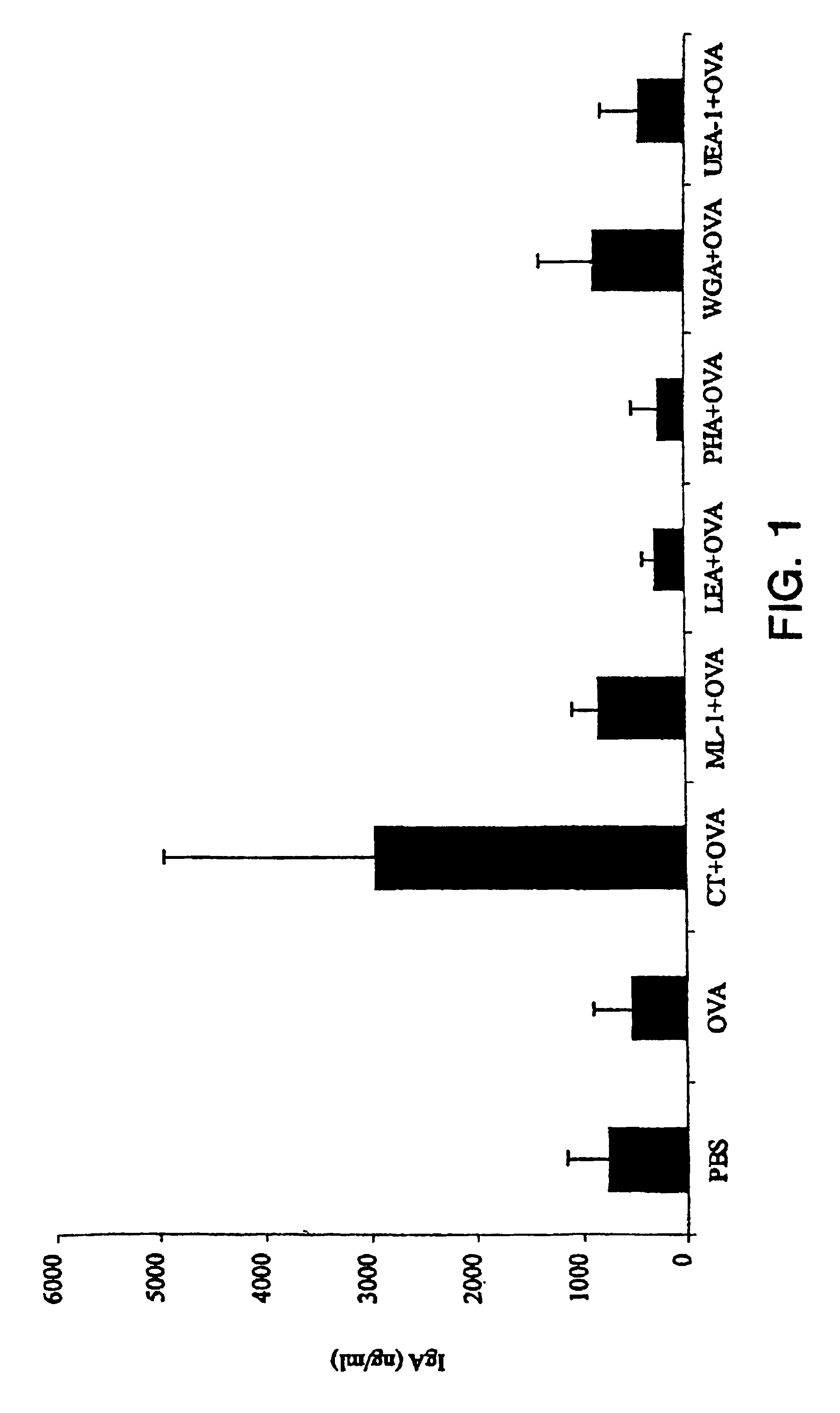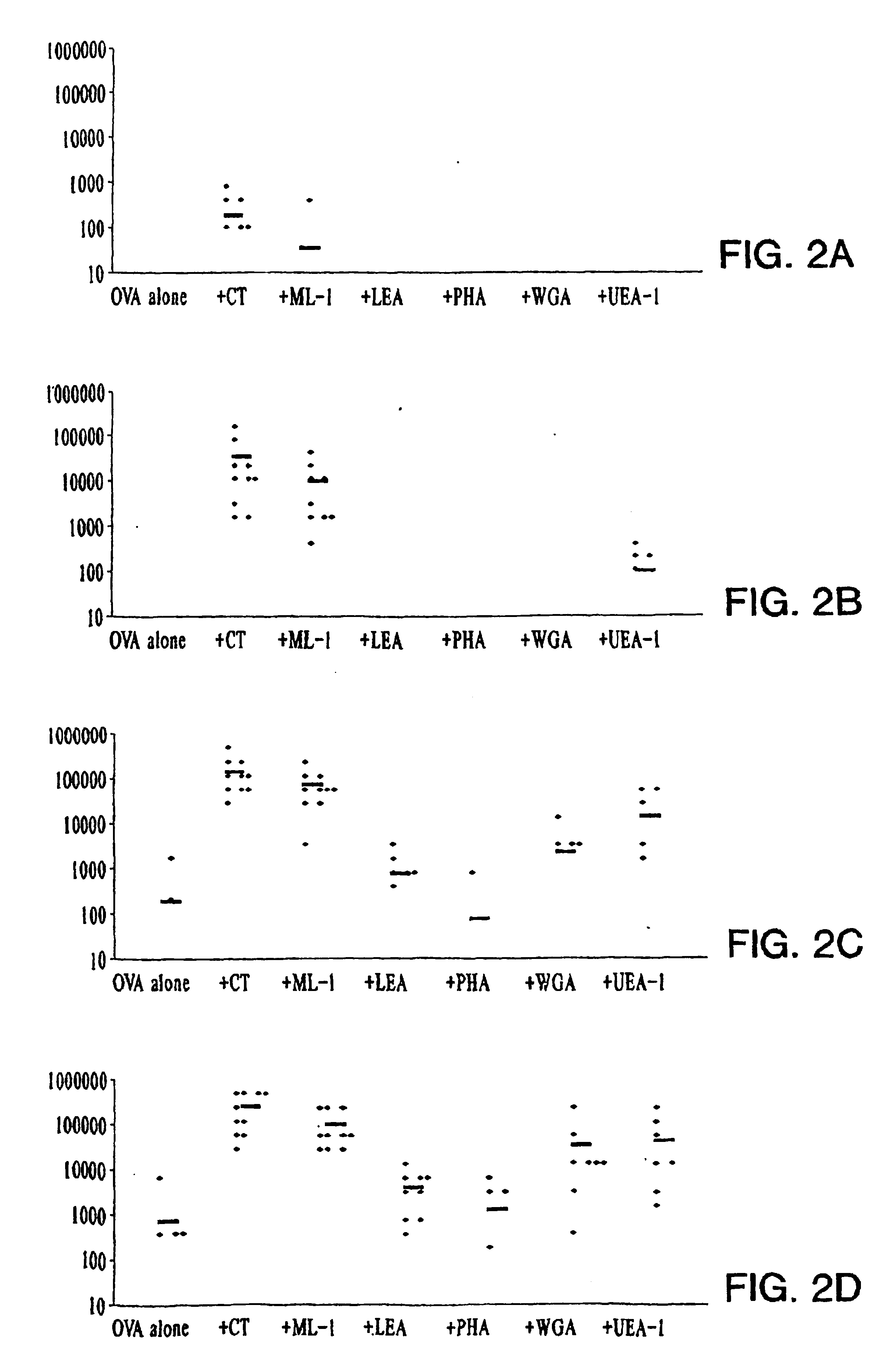Plant lectins as mucosal adjuvants
a technology of plant lectins and mucosa, which is applied in the field of enhancement of can solve the problems of systemic unresponsiveness, toxicity of these molecules, and prevent clinical application, and achieve the effects of increasing an immune response, simple and effective method, and increasing an immune response in a mammal
- Summary
- Abstract
- Description
- Claims
- Application Information
AI Technical Summary
Benefits of technology
Problems solved by technology
Method used
Image
Examples
example 1
Materials and Methods
[0049]Immunogens and lectins. Cholera toxin (CT), ovalbumin (OVA, type V, hen egg) and WGA were obtained from Sigma (Poole, UK). PHA from kidney bean was prepared as described previously (15). UEA-I and LEA were obtained from Vector Laboratories. ML-I was isolated as described previously (16).
[0050]Animals. Eight week old female Balb / c mice (Harlan Olac, Bicester, UK) were given free access to commercial stock diet (Labsure, Manea, UK) and water.
[0051]Mucosal immunization schedule. Groups of mice (n=10) were bled one week prior to the first immunization. On days 1, 14, 28, and 42, mice were immunized intranasally with PBS, OVA (10 μg) alone, or OVA (10 μg) mixed with CT (1 μg), ML-I (1 μg), LEA (10 μg), PHA (10 μg), WGA (10 μg), or UEA-I (10 μg). In other examples, mice were immunized intranasally with 5 μg glycoprotein D2 (gD2) from Herpes simplex virus type 2 on days 1, 14, 28, and 49 alone or in an admixture with 1 μg of either CT, ML-I, ML-II, or ML-III. Mic...
example 2
The Effect of Immunization on Total IgA Levels in Sera and Secretions
[0059]Mice were immunized by the intranasal route on days 1, 14, 28, and 42 with either PBS, OVA (10 μg) alone, or OVA (10 μg) together with CT (1 μg), ML-I (1 μg), LEA (10 μg), PHA (10 μg), WGA (10 μg) or UEA-I (10 μg). Samples were collected two weeks after the final immunization. The results are shown FIG. 1. Data represent the mean±SD.
[0060]After four intranasal immunizations with CT+OVA there was a significant increase in the concentration of total nasotracheal wash IgA (p<0.01) compared with all other groups. Co-administration of CT with OVA did not result in a significant rise in total IgA concentration in sera or the other mucosal secretions sampled. There was no significant effect of immunization with any of the plant lectins on total IgA levels in any of the secretions or in serum.
example 3
The Adjuvant Effect of Plant Lectins on OVA-specific Serum Antibody Responses
[0061]Mice were immunized intranasally on days 1, 14, 28, and 42 with either OVA (10 μg), alone or OVA (10 μg) together with CT (1 μg), ML-I (1 μg), LEA (10 μg), PHA (10 μg), WGA (10 μg) or UEA-I (10 μg). Sera were collected 1 day before each immunization and at the termination of the study. FIGS. 2A-D show the results of this experiment. Points refer to individual data, and the symbol (−) represents the mean titer.
[0062]Two weeks after a single immunization, OVA-specific serum IgG was detected in 5 / 10 mice immunized with CT+OVA and 1 / 10 mice immunized with ML-I+OVA but OVA-specific IgG was not detected in the other groups. After a second dose, higher responses were measured with detectable antibody in all mice immunized with CT+OVA (mean titer 40321) and in 9 / 10 mice immunized with ML-I+OVA (mean titer 11090). Of the other groups, specific IgG was only detected in mice immunized with UEA-I+OVA (mean titer ...
PUM
| Property | Measurement | Unit |
|---|---|---|
| Volume | aaaaa | aaaaa |
| Volume | aaaaa | aaaaa |
| Volume | aaaaa | aaaaa |
Abstract
Description
Claims
Application Information
 Login to View More
Login to View More - R&D
- Intellectual Property
- Life Sciences
- Materials
- Tech Scout
- Unparalleled Data Quality
- Higher Quality Content
- 60% Fewer Hallucinations
Browse by: Latest US Patents, China's latest patents, Technical Efficacy Thesaurus, Application Domain, Technology Topic, Popular Technical Reports.
© 2025 PatSnap. All rights reserved.Legal|Privacy policy|Modern Slavery Act Transparency Statement|Sitemap|About US| Contact US: help@patsnap.com



